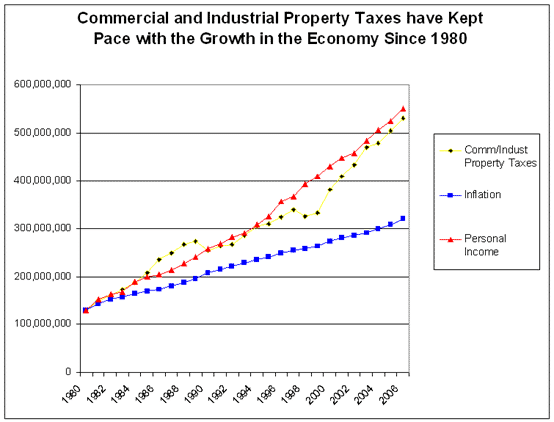
Taxes in Nebraska > Sources of Major State and Local Taxes > Property Taxes > Property Taxes by Sector > Commerical Property Taxes
COMMERCIAL PROPERTY TAXES

| Some activity on the chart above -- such as spikes and troughs -- can be traced to policy decisions made by the Legislature. To view additional information about these changes, click on a bill number below. A chronology of legislative action will open in a new window; the bill you selected will be viewable at the top of the new page. | |
| YEAR | LEGISLATIVE ACTIVITY |
| 1991 | LB 829 |
| 1992 | LB 1063 |
|
Since the early 1990s, commercial and industrial property taxes have kept pace with the growth in the economy. This is true despite the fact that there has been new construction as is the case with residential property. Why is the pattern different There are three factors that may be significant. First, LB 1063 in 1992 changed the valuation methodology for taxable personal property from market value to net book value. Only income-producing personal property is subject to taxation in Nebraska, so this change had no impact on residential sector valuations. Net book value is based on the cost basis for income tax purposes reduced according to a Nebraska depreciation schedule. LB 1063 resulted in a 20% reduction in taxable commercial and industrial personal property valuation in 1992. Also with the net book value approach, the valuation consistently declines, eventually to zero, regardless of the actual value of the property. Another factor is the growth in tax increment financing in the 1990s. Much of the commercial and industrial real property growth has occurred in connection with projects where the taxes on the increased value are pledged to public debt service for infrastructure improvements. The property taxes paid for this increment do not appear on the certificate of taxes levied and are not available to local governments other than the municipality that issued the debt. Finally, agricultural processing machinery, mainframe business computers and certain aircraft purchsed by businesses that have invested at least $10 million in property in Nebraska and hired at least 100 new employees have been eligible for an exemption of such personal property under the Employment and Investment Growth Act. These exemptions, plus distribution equipment in some instances have been retained, although the exemption was shortened to ten years under the Nebraska Advantage Act, beginning in 2006. |